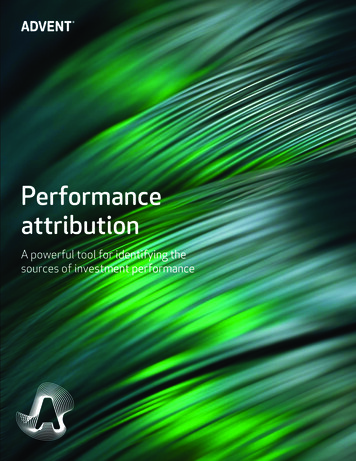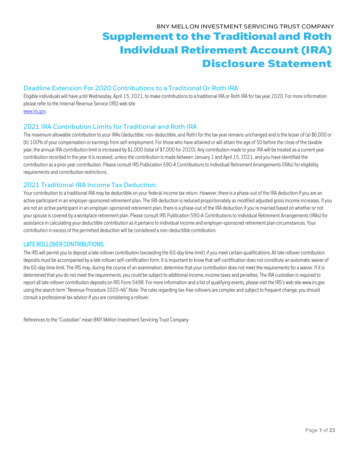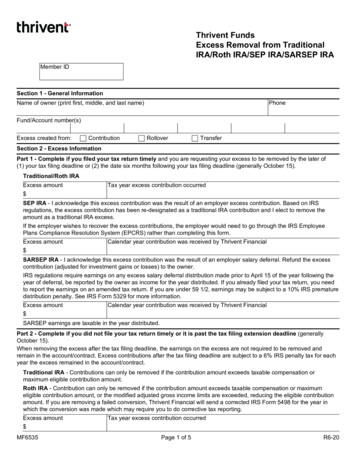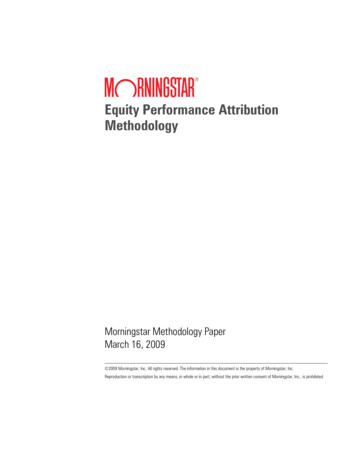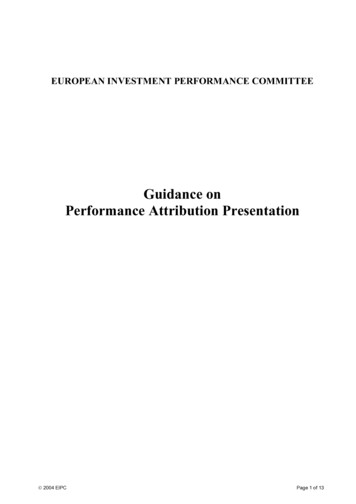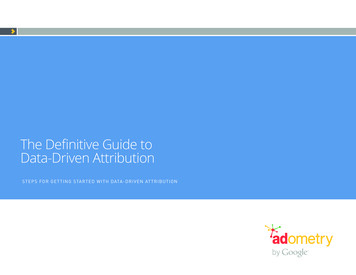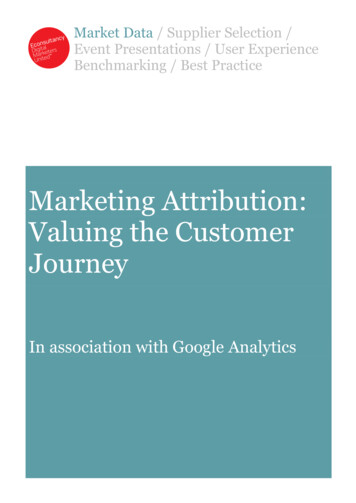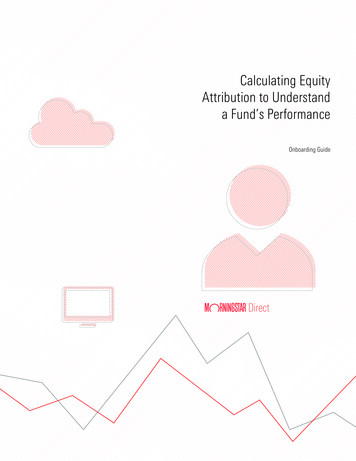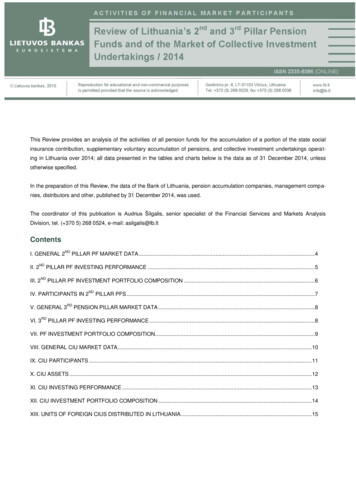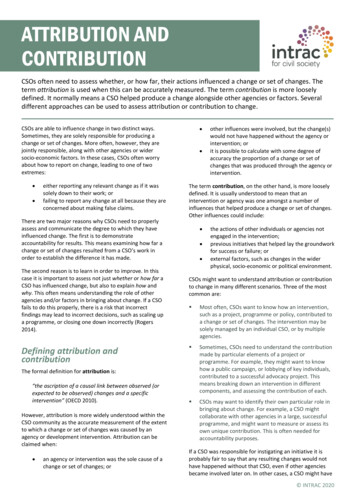
Transcription
ATTRIBUTION ANDCONTRIBUTIONCSOs often need to assess whether, or how far, their actions influenced a change or set of changes. Theterm attribution is used when this can be accurately measured. The term contribution is more looselydefined. It normally means a CSO helped produce a change alongside other agencies or factors. Severaldifferent approaches can be used to assess attribution or contribution to change.CSOs are able to influence change in two distinct ways.Sometimes, they are solely responsible for producing achange or set of changes. More often, however, they arejointly responsible, along with other agencies or widersocio-economic factors. In these cases, CSOs often worryabout how to report on change, leading to one of twoextremes: either reporting any relevant change as if it wassolely down to their work; orfailing to report any change at all because they areconcerned about making false claims.There are two major reasons why CSOs need to properlyassess and communicate the degree to which they haveinfluenced change. The first is to demonstrateaccountability for results. This means examining how far achange or set of changes resulted from a CSO’s work inorder to establish the difference it has made.The second reason is to learn in order to improve. In thiscase it is important to assess not just whether or how far aCSO has influenced change, but also to explain how andwhy. This often means understanding the role of otheragencies and/or factors in bringing about change. If a CSOfails to do this properly, there is a risk that incorrectfindings may lead to incorrect decisions, such as scaling upa programme, or closing one down incorrectly (Rogers2014).Defining attribution andcontribution The term contribution, on the other hand, is more looselydefined. It is usually understood to mean that anintervention or agency was one amongst a number ofinfluences that helped produce a change or set of changes.Other influences could include: However, attribution is more widely understood within theCSO community as the accurate measurement of the extentto which a change or set of changes was caused by anagency or development intervention. Attribution can beclaimed when: an agency or intervention was the sole cause of achange or set of changes; orthe actions of other individuals or agencies notengaged in the intervention;previous initiatives that helped lay the groundworkfor success or failure; orexternal factors, such as changes in the widerphysical, socio-economic or political environment.CSOs might want to understand attribution or contributionto change in many different scenarios. Three of the mostcommon are: Most often, CSOs want to know how an intervention,such as a project, programme or policy, contributed toa change or set of changes. The intervention may besolely managed by an individual CSO, or by multipleagencies. Sometimes, CSOs need to understand the contributionmade by particular elements of a project orprogramme. For example, they might want to knowhow a public campaign, or lobbying of key individuals,contributed to a successful advocacy project. Thismeans breaking down an intervention in differentcomponents, and assessing the contribution of each. CSOs may want to identify their own particular role inbringing about change. For example, a CSO mightcollaborate with other agencies in a large, successfulprogramme, and might want to measure or assess itsown unique contribution. This is often needed foraccountability purposes.The formal definition for attribution is:“the ascription of a causal link between observed (orexpected to be observed) changes and a specificintervention” (OECD 2010).other influences were involved, but the change(s)would not have happened without the agency orintervention; orit is possible to calculate with some degree ofaccuracy the proportion of a change or set ofchanges that was produced through the agency orintervention.If a CSO was responsible for instigating an initiative it isprobably fair to say that any resulting changes would nothave happened without that CSO, even if other agenciesbecame involved later on. In other cases, a CSO might have INTRAC 2020
supported work instigated by other agencies, in which caseits role might be to have enhanced the change process inorder to ensure that changes were better, or were realisedmore quickly. And in some cases – for instance whenmultiple CSOs engage in joint advocacy or campaigningwork – a CSO might simply have tried to increase thechances of success.Therefore, there are many different possibilities, and manydifferent ways in which a CSO or a developmentintervention can contribute to change alongside others.Assessing attribution or contribution is rarely an easy taskfor CSOs. This is partly because much of their work iscarried out through partnerships, networks and consortia;and partly because long-term engagement in communitiesoften builds on previous development interventions.Contribution and complexityIt is much easier to assess contribution when changes areclear, measurable and short-term. For example, CSOs arenormally able to attribute outputs (deliverables) to theirinterventions. They may also find it relatively easy todemonstrate how outputs contribute to immediate change.For example, nutrition programmes often result inimmediate changes to children’s weight; eye-savingoperations can restore lost sight; and training might resultin immediate, increased awareness and understanding ofan issue.As changes become further removed in time fromdeliverables, and more difficult to measure, it becomesharder to assess contribution. Many CSOs work in areassuch as advocacy, capacity building or mobilisation ofcommunities, where change often evolves slowly. Theremay be multiple interventions over long time periods,which means much more opportunity for other factors toinfluence change.It is even harder to assess contribution within complexprogrammes, dealing with issues such as governance,democracy and climate change. Here there are usuallymultiple agencies involved, and interventions are oftenspread across years if not decades. It might be possible toshow contribution to short-term changes directly related toa CSO’s work. But it may be extremely difficult, if notimpossible, to calculate overall contribution to longer-termchange. For example, a CSO might be able to show that itsawareness-raising campaign helped increase understandingof the needs of people living with HIV/AIDS. But it may beimpossible to precisely measure the contribution of thatawareness-raising campaign to an overall change indiscourse amongst local politicians.Likewise, in humanitarian work it is often relatively easy toassess contribution to immediate, dramatic, changes in theaftermath of a natural disaster. But it is much harder toassess contribution to longer-term change resulting fromreconstruction efforts, especially when multiple donors anddifferent agencies become involved.Overall, therefore, the more straightforward thedevelopment initiative, and the closer changes are in timeto the initiative, the easier it is to assess contribution. Thismeans CSOs need to be realistic about what they canreasonably claim. And it is why most CSOs tend to focus oncontribution rather than attribution.Methods for assessing attribution orcontributionA number of different methodologies can be used to assessattribution and contribution to change (see Mayne 2012;Rogers 2014; Stern et al. 2012; White and Phillips 2012).These are described below. They are not mutuallyexclusive, and there is often much overlap between them.Statistical studies depend on the statistical analysis ofcorrelations. Data is first collected on different variablesacross a large number of cases. Then the extent to whichthe variables are correlated is used to assess (or estimate)how far an intervention has contributed to change. As avery simple example, a CSO seeking to improve hygiene in atown could correlate the number of hygiene-awarenesssessions attended by communities with changes inincidence of water-borne disease. If communities whoattended the most sessions had the highest reduction inwater-borne disease (on average) it would be possible toestimate how much of this reduction was directly related tothe CSO’s work. In reality, statistical studies are usuallymuch more complicated than this, and often handlemultiple variables at the same time.Counterfactuals are the basis for experimental approaches(such as randomised control trials) and quasi-experimentalapproaches. They compare change in a group of individualsor organisations receiving support with change in a groupnot receiving support, or receiving a different kind ofsupport – known as comparison or control groups.Contribution is assessed by calculating the difference inchange between those receiving support and the control orcomparison groups, and then attributing this to the supportprovided.Theory-based methods rely on the development of atheory of change or impact pathway, which maps out thepath between interventions and desired changes. Evidenceis sought at each stage of the pathway to try and develop aplausible (believable) case that explains how changes havebeen produced. If a CSO can establish that change hasoccurred at each stage of the process, they can show howand why the desired change(s) happened, and therebydemonstrate their own role in the process. Some theorybased methods, such as process tracing, also involve thedevelopment and testing of alternative theories of change.This is done to eliminate other potential contributions tochange, or to assess their relative importance.Case-based methods rely on selecting multiple cases wherechange has or hasn’t happened, and asking commonquestions across all the cases to help identify which factorsor interventions were most important in producing change.In some circumstances this can help a CSO identify its owncontribution to change. The best-known case-basedmethod of this kind is Qualitative Comparative Analysis(QCA), which is described in another M&E Universe paper. INTRAC 2020
Participatory methods are perhaps the most commonmethods used by CSOs outside of major evaluations orresearch studies. Participatory methods involve askingdifferent stakeholders what they think contributed to achange or set of changes. This helps a CSO gain insight intothe role that a development intervention played in bringingabout change. Participatory methods tend to rely onqualitative methods of data collection, such as interviews,focus-group discussions and observations. They are seen bysome as less rigorous than other methods of assessingcontribution, and may be particularly subject to bias. Forexample, beneficiaries may tell a CSO what they think itwants to hear, and might over-emphasise the role of a CSOin contributing to change (White and Phillips 2012).Obvious causality. Some changes are obviously the resultof particular interventions, and no further work is neededto establish contribution. This may be because there is noobvious alternative explanation – for example, peoplerecovering sight after an eye operation, or peoplecompletely changing their views on people living withHIV/AIDS following a targeted awareness-raising campaign.Or it may be because the science of an intervention is wellknown and tested. For example, it is accepted that well-runvaccination programmes result in the lowering of certaindiseases (Rogers 2014).Each of these methods have different strengths andweaknesses, and conditions under which they do or do notapply (Stern et al. 2012). For example: Statistical studies and counterfactuals require asufficient number of cases to enable statisticaltechniques to work properly.Counterfactuals are good at assessing whether anintervention has made an overall contribution tochange, but do not help explain how or why. Theory-based methods can help explain how anintervention contributed to change, but are notalways able to show the precise level of changethat can be attributed to that intervention.Participatory methods are better able to workbackwards – assessing change and then workingbackwards to assess how much of a contributionan intervention or set of interventions has made.Theory-based methods and participatoryapproaches are better able to assess the relativecontribution of many different agencies and/orexternal factors.Cartwright (2007) divides the methods into two differentcategories. The first (statistical studies and counterfactuals)are those that can provide a definite answer about howmuch change can be attributed to an intervention oragency, but can only be applied in a limited range ofcircumstances. The second category covers methods thatcan be applied in almost all circumstances, but do notenable attribution to be measured with precision.More than one method can be applied at the same time,and it is relatively common in large evaluations to pursuemultiple methods. The box below contains some commonmethodologies for data collection and analysis (describedelsewhere in the M&E Universe), alongside the approachesused to assess contribution.SummaryHow far a CSO needs to go in assessing contribution to achange or set of changes depends on many circumstances.If a CSO is undertaking a major project or programme,where M&E findings may have widespread implications, itmay need to invest significant resources in investigatingMethodologyApproachesRandomised control trials and quasiexperimental approachesCounterfactuals: Control or comparison groups are used to compare changes in groups receivingproducts or services through a development intervention with those not receiving them. Thedifference is attributed to the intervention.Qualitative comparative analysis(QCA)Case-based: Multiple cases are investigated: some in which change happened and some where itdid not. Different combinations of factors that produced change are investigated.Most significant change (MSC)Participatory: Participants are asked to identify the most significant changes that have occurred intheir lives to which a project or programme has contributed.Contribution analysis and processtracingTheory-based: Both methodologies rely on the development of a theory of change. Evidence ofchange is then sought at each level of the theory of change, thereby enabling the pathways ofchange to be understood.Baselines and endlinesStatistical studies, Obvious causality, Participatory: Contribution might be assessed betweenbaseline and a repeat study by performing statistical analysis to correlate inputs/outputs andchanges. Alternatively, changes might be investigated through participatory methods. Sometimesit may be obvious that a set of inputs is responsible for any changes identified.Participatory Learning and Action(PLA)Participatory: Various participatory tools, including maps, calendars and timelines, are used tobuild up a picture of change, and to examine beneficiaries’ perceptions of contribution to change.Outcome harvestingParticipatory: Stories of change always include a narrative assessment of how an agencycontributed to the change. Most often, this is generated through interviews with stakeholders.Organisational assessment tools(OCATs)/rating toolsParticipatory: Tools used to rate changes in capacity often contain supplementary questions orratings to assess contribution.Impact gridsParticipatory: Multiple cases are charted on a grid or graph. One of the axes shows the extent ofchange seen within the cases; the other indicates the degree of contribution of an agency orintervention. INTRAC 2020
contribution through statistical studies or counterfactuals.But it is usually not necessary to go this far. There are manysimple ways of assessing contribution, most of which relyon theory-based or participatory methodologies that seekthe judgement of different stakeholders. One example isprovided in the case study below.A key factor is the complexity of the initiative. CSOs thatoperate independently, delivering services directly tocommunities, may find it much easier to assess theircontribution to change. CSOs working throughpartnerships, networks or coalitions, or those working incomplex areas of change such as governance, democracyand empowerment, often find it much harder to isolatetheir own particular contribution to change.For many CSOs, it is rare that their work will leadexclusively to desired changes. The task, therefore, is toproduce a case (or set of cases) that shows a plausible(believable) link between their intervention(s) and anychanges. This usually means reporting change alongsideany evidence (or theory) of contribution. It also meansacknowledging the contribution of other agencies orexternal factors. If claims to contribution are not explicitlyrecorded, along with supporting evidence, CSOs risk beingaccused of misleading people or of over-claiming.Case study: KLP in SudanThe Kulana Liltanmia Programme (KLP) in Sudan worked to support relations between citizens and local government authorities.Work was carried out through national and local civil society partners. At the end of the programme, a contribution analysis wascarried out with each partner. This was based on a case study outlining what changes the partner believed had occurred in relationsbetween civil society and government, or different parts of civil society. Based on each case study, KLP and partners developed animpact pathway showing the sequence of changes from the development intervention through to outcomes and impact. Evidencewas sought at each level of the impact pathway. This used existing knowledge at first, but was supplemented through additionaldata collection exercises where necessary. Alternative explanations for change were also sought and investigated. Eventually, KLPand partners produced a set of finalised case studies, outlining change and the pathways to change, with supporting evidence ateach stage of the process.Based on the finalised case studies, KLPthen used a simple rating system toassess each partner project’scontribution to change. The ratingsystem was applied across two differentdimensions: the importance of theproject to any changes observed, andthe influence of other factors andagencies. This allowed KLP to build up itsunderstanding of contribution to changeacross multiple projects, and also tounderstand how and why change hadoccurred. The rating scheme used isshown in the box opposite.Further reading and resourcesSome of the methodologies referenced in this paper can be accessed by clicking on the links below.Qualitative comparative analysisRandomised control trialsQuasi-experimental approachesProcess tracingContribution analysisParticipatory learning and actionMost significant ChangeOutcome harvesting INTRAC 2020
References Cartwright, N (2007). Hunting Causes and Using Them: Applications in philosophy and economics. Cambridge UniversityPress. Mayne, J (2012). Making Causal Claims. Brief 26, Institutional Learning and Change (ILAC) Initiative. OECD (2010). Glossary of Key Terms in Evaluations and Results Based Management. OECD, 2002, re-printed in 2010. Rogers, P (2014). Overview: Strategies for Causal Attribution; Methodological Briefs: Impact Evaluation No. 6. UNICEF,Florence, Italy, 2014. Stern, E; Stame, N; Mayne, J; Forss, K; Davies, R and Befani, B (2012). Broadening the Range of Designs and Methods forImpact Evaluations: Report of a study commissioned by the Department for International Development (DFID). Working paper38, April 2012. White, H and Phillips, D (2012). Addressing Attribution of Cause and Effect in Small-n Impact Evaluations: Towards anintegrated framework. Working Paper 15, 3ie, June 2012.Author(s):Nigel SimisterContributor(s):Dan James andAlison NapierINTRAC is a specialist capacity building institution for organisations involved in international reliefand development. Since 1992, INTRAC has contributed significantly to the body of knowledge onmonitoring and evaluation. Our approach to M&E is practical and founded on core principles. Weencourage appropriate M&E, based on understanding what works in different contexts, and we workwith people to develop their own M&E approaches and tools, based on their needs.INTRAC TrainingM&E Training & ConsultancyWe support skills development and learning on a range ofINTRAC’steam ofhighM&Especialistsoffer consultancyandthemes throughqualityand mcoreskillsdevelopmentonline and tailor-made training and coaching.through to the design of complex M&E systems.Email: training@intrac.orgTel: 44 (0)1865 201851Email: info@intrac.orgTel: 44 (0)1865 201851M&E UniverseM&E UniverseFor more papers inForinthemoreM&EpapersUniversethe seriesM&E Universeclick theseriesthehomeclickbuttonhome button INTRAC 2020
Participatory methods are perhaps the most common methods used by CSOs outside of major evaluations or research studies. Participatory methods involve asking always able to show the
